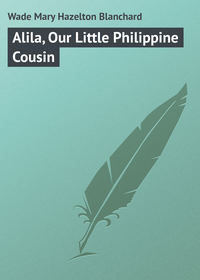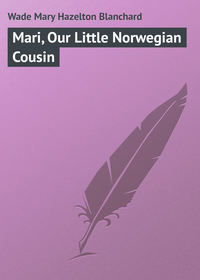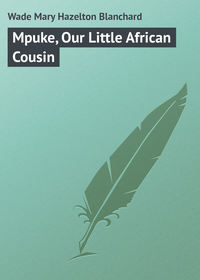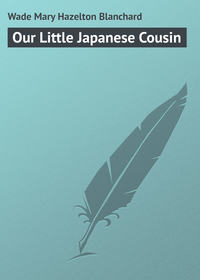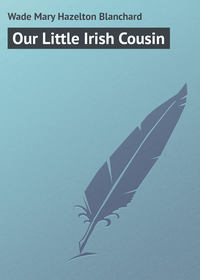 полная версия
полная версияLittle Folks of North America
The owner of such a farm is usually a rich man who lives with his family in a large stone house surrounded by high walls. There is a courtyard where beautiful trees and plants are growing and fountains are playing. The wife and children of the owner wear dainty garments and are waited upon by many servants. They have the choicest food, – fruits of many kinds, chicken cooked in different ways, tortillas of course, besides all sorts of delicacies prepared by excellent cooks.
The workmen have very different homes. They live in small huts of one or two rooms, and built of mud or adobe. Inside are rough stone fireplaces, and a few mats are spread on the floor. Here the children and their parents sit while they eat their simple meals of tortillas and black beans, and here they stretch themselves at night for sleep. They are quite happy, however. Outdoors are the birds, the flowers, and the beautiful sunshine. They need few clothes and they do not go hungry.
There are usually large dairies on these farms where women are busy making the rich milk into butter and cheese. Thousands of pounds are often sent to market from one such farm during the year.
You have probably seen century plants in the hot-houses you have visited, and have been told that they belong to the aloe family. When the Spaniards first came to Mexico they saw the Indians making paper from the pulp of the leaves of the aloe plant and twine from its fibers. The sharp thorns on the edges of the leaves furnished needles for the Indian women, and the sap of the aloe was made into pulque, the favorite drink of the natives. They also made hammocks from the fibers and thatched the roofs of their huts with the big leaves, lapping one over the other like shingles. In fact, the Indians made so many uses of the aloe plant that the Spaniards thought it worth while to raise it in large quantities for themselves.
The aloe has thick, pointed leaves sometimes ten feet long. It blossoms about once in ten years, when it sends a flower stalk twenty or thirty feet up into the air. At the very top an immense cluster of greenish-yellow blossoms appears. All the strength of the plant goes into these blossoms for, as they open, the leaves wither and die.
The Indians have learned to tell when the plant is getting ready to send up its giant flower-stalk. Just before it appears they cut out the heart with a sharp knife, leaving only the thick, outside rind of the stem. The sweet sap that should have gone to feed the flower-stalk begins to ooze into the hollow and continues to do so for several weeks. The Indians, who have discovered the right time to cut into the plant to prevent its flowering, have also learned that the sap can be used in making the drink which they call pulque.
The city of Mexico is a beautiful one, with high stone walls around it, a large square in the centre, and broad streets running at right angles to each other. Nearly all the houses are built of stone, with flat roofs on which the people sit in the evening to enjoy the cool breezes and watch the stars twinkling merrily in the heavens above.
The children of the big stone houses can play in inner courtyards among flowering plants and fountains. But when they leave their homes to go out into the city they must pass through heavy doors studded with nails and heavily chained. The house windows that face the street have iron bars across them, so that at first these houses seem like fortresses. But when one passes to the back part of such a building and looks out through the windows there upon the pretty courtyard with its fountains and flower-beds, or takes a comfortable chair on one of the balconies, with its gilded balustrades covered with trailing vines, he begins to feel as though he were in a beautiful palace.
The great square in the middle of the city is beautiful with trees and flowers, statues, and walks paved with snowy marble. In the long-ago a temple stood here where hundreds of people were sacrificed to the gods in whom the Aztecs believed. On one side of the square stands the house of the president, and on another there is a grand cathedral where the Mexicans and their children go to worship. The cathedral doors are always open so that any day you may go inside and find people kneeling there. Rich and poor, grand ladies in delicate muslins and jewels, and the poorest Indians with their packs of fruit or coops filled with chickens still on their backs, kneel in prayer side by side.
Many of the children who have been to the cathedral to worship, stop as they leave it before the flower-decked stands under the trees, where women are busy selling cool drinks and sweetmeats. Or perhaps they are more interested in the Indians wandering about with cages of humming-birds and parrots, and they beg their parents or older friends who are with them to buy one of the birds to carry home.
As the children go on their way they pass many a horseman riding through the streets with broad hat shading his face, and with leggings trimmed with buttons and silver braid. Silver spurs shine brightly at his side in the sunlight, as also do the gorgeous trappings of his horse.
There are all sorts of people to be seen on the streets of Mexico. There are Indians with packs of all sorts on their backs. There are girls in gaily striped skirts selling fruit. There are water-carriers in leather aprons with large earthen jars on their backs and smaller ones hanging down in front; there are bird-sellers with flower-trimmed cages; there are the Indian policemen who carry lanterns at night, which they place in the middle of the street while they nap in the doorways close by. These naps must be very short, however, because every fifteen minutes it is the business of the policemen to blow shrill whistles, and at every hour to call the time.
The Big MarketThe boys and girls of the city often visit the big market which is only a short distance from the cathedral. It is surrounded by high stone walls and on every side there is a gateway through which the people are constantly passing.
The sides of the market are lined with shops where people are busy selling all sorts of goods. There are the stalls of butchers where only meats are to be seen. There are stands of fruit that fill the air with sweet odors. There are vegetables of many kinds, furniture, and dress-goods of all colors. There are shops where fried meats are sold to hungry people in need of a lunch. There are great piles of cocoanuts and bananas heaped upon the ground. There are fish from both lake and ocean. Strangest of all are the cakes made out of marshflies. These flies are found in great numbers along the muddy banks of the Mexican lakes. There they lay their eggs among the flags and rushes and are killed by the Indians and made into a paste.
The middle of the market is filled with Indians who shade themselves and their wares from the hot sun by large squares of matting perched on poles. Here is one man with coops filled with chickens, and another with a stack of earthen dishes made at home. Just beyond him is a woman with a baby on her back. She is standing by the side of a patient donkey with panniers filled with melons or peaches, hanging from its sides, and a happy little two-year old child on its back. Some of the people who are busy selling their wares have come many miles and left their homes before sunrise. They have brought their families along with them, so that half-naked children and babies of all ages are to be seen everywhere. Some of them are munching fruit, others playing hide-and-seek among the crowds, while many a tiny baby is nodding itself to sleep on its mother’s back or crying with all its might for a little attention.
The MuseumsThe children of the city are fond of visiting the museums, for there they can see many of the wonderful things made by the Aztecs in the time of their great ruler, Montezuma.
First of all they stop before a large bed of flowers in the court, in the center of which is the “sacrificial stone” where, in the old days before the coming of the white men, people were offered up to the gods in whom they believed. Near by are the hideous statues of two of these gods. They are not pleasant to look at, so the visitors pass quickly into the building where they can see Aztec vases ornamented with strange carving, masks of volcanic glass, the wonderful feather shields of Montezuma, books filled with picture-writing, and images made of wax and representing all kinds of life in Mexico. There is the Indian with his pack, the charcoal-seller with his donkey beside him laden with coal, the flower-vender with bouquets of flowers in her hands.
Children are never tired of looking at these wax figures, but however long they may stay, they do not like to leave the museum without at least a peep at the feather pictures made in the time of Montezuma.
These pictures are entirely of birds’ delicate feathers, laid over each other so carefully that if you were to examine them ever so closely you would not be able to tell how the work was done. The pictures are as wonderful in their way as fine paintings. Only few Indians know the secret of making them, which is guarded carefully and handed down from father to son.
The Floating GardensMost of the vegetables raised for the people of Mexico are brought in the early morning from the floating gardens a short distance from the city, where there are some lakes. A kind of water-plant grows in these lakes very fast and mats together, making marshy beds.
Long ago, in the time of Montezuma, the Aztec farmers learned to make gardens out of these floating masses of weeds. They cut out large squares which they covered with mud drawn up from the bottom of the lake. The soil was rich and moist so that no place in the world could be better for plants. Flower and vegetable seeds were sown and in a short time beautiful gardens were growing.
From that day to this Indians have been busy tending these floating gardens. They pass from one to another in canoes, gathering vegetables and flowers for the city market. One boat will be filled with lettuce, another with luscious red tomatoes, while still another will be loaded with bright-colored flowers. It is a pretty sight to see them as they move slowly along through the Viga Canal that leads from the lakes to the city. Again and again the Indians paddling along with their loads are passed by pleasure boats filled with young people, who make the air resound with the odd sweet songs of the country.
VolcanoesSouth of the city of Mexico there is a range of hills, and beyond these is a chain of volcanoes, two of which bear the names of Popocatapetl and Iztacsihuatl. It is much easier, however, to think of them as “Smoking Mountain” and “The Woman in White,” for such are the meanings of these long words. Both these volcanoes wear garments of snow and they look so peaceful that the children of Mexico are not troubled with the thought of what might happen if they should awake in fiery anger some day and send out streams of red-hot lava over the country below.
The slopes of Popocatapetl are dotted with the huts of Indians who earn their living by getting loads of sulphur from the crater of the volcano.
The highest mountain peak in Mexico is Orizaba, or the “Star of the Sea.” As you sail towards the eastern shore of Mexico and when you are still so far away that no other part is in sight, the lofty volcano Orizaba appears before you with its summit in the clouds. The Indians chose a fitting name for it, because it certainly seems to rise out of the sea.
Among the MinesWhen the Spaniards became the rulers of Mexico they found themselves the owners of the richest silver mines in the world. A great part of the silver used to-day came from those mines. Although immense fortunes have been made in the country for hundreds of years, yet the mines are still rich in the precious ore. They are owned by white men, but the work of getting the silver is done mostly by Indians. Mules are sometimes used to carry the ore from the dark caverns underground to the bright world outside, but much of even this work is done by the Indians themselves, who climb up the steep sides of the mines with heavy loads on their backs day after day.
When the silver is found it is generally mixed with sulphur, but sometimes a lump of the pure metal is turned up. One of these lumps weighed four hundred and twenty-five pounds, and was worth eight thousand dollars.
The miners sometimes try to steal the silver by hiding it in their hair, their ears, or between their toes. They are carefully watched for this reason, so they seldom succeed.
Copper is also found in the mines of Mexico and some of it is sent to the United States.
The children of Mexico never need to leave their country for the sake of a change, for by traveling a few miles, they can enjoy either cold weather or hot; they can see the trees and plants, can hear the birds, and can pick the flowers belonging to lands that stretch from the frozen north to the burning regions of the equator.
CHAPTER IX
Little Folks of Central America
Now let us make a short visit to the children of Central America. Perhaps it would not be well for us to stay with them long unless they live in the high valleys of the mountain country along the western shore, for the lowlands are hotter and even more moist than those of Mexico. Fever lies in waiting for strangers in the lowlands; swarms of mosquitoes are ready to attack us on every hand, centipedes and scorpions are hidden in the grass at our feet, so that we are quite willing to hasten towards the hill country as quickly as possible. Even here we feel in danger, for the high valleys we enter lie hidden under the very shadow of a row of volcanoes that stretch from north to south through the land. Many of these are quite wide-awake and show this in various ways, some by the clouds of smoke that rise out of their craters, or by the odor of sulphur that reaches our noses, or perhaps by the shaking of the earth beneath our feet.
One of the highest of these peaks is called Agua which, from time to time, sends out jets of boiling water.
The children of Central America are quite used to earthquakes, which they feel many times during the year. At any moment, in the midst of their play, at dinner time, or during a walk through the streets, the ground may suddenly tremble under their feet, they become dizzy and light-headed, and perhaps there is a rumbling sound in the air around them. If they are away from home, they hurry back to seek safety beside their mothers.
A minute afterwards the danger may pass by and the play or dinner or walk goes on as before. Yet there are ruined cities in the country to tell the story that there have been terrible earthquakes in past times when homes were destroyed, and men, women and children lost their lives before they had time to flee for safety.
The children of Central America are much like their brothers and sisters of Mexico. There are the Indians who are little troubled by the heat and mosquitoes, there are the white boys and girls whose people came from Spain, and there are the little half-castes.
Some of these children live near dense forests where their fathers are busy cutting down valuable mahogany and logwood trees, which are shipped to other lands to be made into elegant furniture. It is so hot in many of these forests that the men do their work at night with flaming torches to give them light.
It is a strange sight. All around is heavy darkness except in the cleared space among the trees where the torch-lights show patient oxen plodding along with their heavy loads, and their half-naked drivers snapping their whips and calling in loud voices to the animals and each other. Through it all comes the sound of the whip and axe, and the snapping of the big trunks as they fall to the ground.
Logwood, from which a valuable dye is obtained, is the name of another valuable tree found in the forests of Central America, as also is the lignum vitæ, or wood of life. From both logwood and lignum vitæ are extracted medicines which physicians often use.
In Central America people need to be careful when they are wandering through the thick grass or along the edge of a forest, for poisonous snakes lurk about and the bites of some of them may cause much pain and suffering.
Sometimes the boys bring home winged squirrels which they have caught while flying from tree to tree, but these little creatures do not enjoy being made captive. They love their wild life in the woods, where they are free to scamper over the ground; or spreading their legs, to fly about among the branches of the trees as they will.
Along the southern coast of Central America the children find beautiful mother-of-pearl shells on the water’s edge. As the sunlight falls upon these shells the loveliest colors are seen on the clear surface, – delicate pinks and blues and violets. After the children are tired of playing with the shells they can easily sell them, for travelers are ever ready to buy them as remembrances of their stay in the country.
In the forests of Central America there are many rubber trees, where Indian boys help their fathers gather the sap which will afterwards be made into storm coats and shoes to protect the children of the United States from rain and snow.
In the lowlands and on the slopes there are many banana orchards, which furnish all the fruit the little folks and their parents wish for, as well as many a shipload for the people of other lands.
Some of the white children of the country live on coffee plantations where Negro and Indian workmen care for the trees and pick the berries for market.
There are also places in Central America where the indigo plant is raised on account of the blue dye that is obtained from it. This, too, is sent away from the country in ships, as well as coffee and mahogany, bananas and rubber.
Central America is divided into several republics, each one of which is quite independent of the others. As you travel through them southwards, the country becomes more and more narrow till you come at last to the Isthmus of Panama, which joins North and South America.
The people of the United States are now very busy building a canal through this isthmus to join together the Atlantic and Pacific Oceans. As you look at the map it seems an easy enough matter.
You think, “Why, that canal ought to be finished in a short time and should not cost much, either, for the distance across the canal is not more than twenty-six miles at the narrowest part.”
But you must remember in the first place that the canal can not be dug in a straight line; also, that it must pass through the heart of high mountains and that solid masses of rock must be broken up, bit by bit. Then again, the climate of the lowlands is very unhealthy during the wet season of the year and the workmen suffer from fever and other kinds of sickness. Besides, it has been hard to get men who understand the work to go there. For these reasons and still others the building of this canal is a tremendous undertaking and will cost billions of dollars before it is finished.
The people of France began it many years ago, but gave it up after two-fifths of it had been dug. The people of the United States undertook to finish it, and at present everything is going on well. They paid France for what she had already done on the canal and bought the land through which it is to pass. Moreover, they have built comfortable homes for the workmen and have done many things to prevent the fevers that attack persons so easily on account of the damp, hot climate.
So it has come about that on the Isthmus of Panama there are now many American children whose fathers are busy on the canal and have brought their families to live with them there. Schools have been built where these children study the same lessons as their playmates at home. Mother Nature gives them other lessons too, for they see many curious sights in the country around them, different trees and plants, different flowers and birds from those of their homeland. If they enter the forests they can see the parrots and monkeys among the tree-tops, and possibly wild hogs among the underbrush. They can pick flowers which are beautiful, but without fragrance. They can tap milk trees and get a thick, creamy liquid which will satisfy their hunger. They must be watchful, however, in this strange country, for immense ants are ever ready to sting their tender toes, and poisonous snakes lie hidden in the thick grass.
Not far from the homes of the little Americans there are villages where Chinese children are living with their parents, since many Chinamen are at work on the canal. There are Negroes, too, as well as the white men and the native Indians.
By and by, when the great undertaking is finished and big ships from all parts of the world are constantly passing through the canal, it will be a very lively place and many will be the visitors to that part of North America.
CHAPTER X
Little Folks of the West Indies
When Columbus discovered the New World he landed on a small island southeast of North America where the gentle red people greeted him as a god from heaven. You probably know the story, – how Columbus thought he had reached India, the land of silks and spices, and how he accordingly called the red men whom he met, Indians. In fact India was far away, and instead of landing on its shores, the great sailor had reached one of a long chain of islands reaching from North to South America, which we know to-day as the West Indies.
The red people who greeted Columbus did not live long after the coming of the Spaniards who followed him. They were made to dig gold in the mines for their cruel masters, and to do other hard work to which they were not used. They soon sickened and died under the hard treatment. Many of them, alas, were killed by the white men in sport, so that before long not an Indian was left in all the islands.
To-day many white children, whose people came from Spain long ago, are living in happy homes in the West Indies. Besides them, there are hundreds of little Negroes with kinky hair and rolling eyes, whose homes are tiny huts thatched with palm leaves, and who wear little or no clothing. They bask in the sunshine and play in the clear waters along the shore and are as happy as the day is long.
The beautiful islands of the West Indies lie in the hot belt of the world, and the people who live there know but two seasons, a wet and a dry. For several months rain falls every day, – not all day long, however, keeping the boys and girls indoors, but there are heavy showers every morning, after which the world looks lovelier than ever. It is far pleasanter then than in the dry season, when the trees and plants lose their freshness and the dust is thick upon everything around.
Although the West Indies lie in the hot belt, yet cool breezes from the ocean blow over the land throughout the year so that the people who live there do not suffer from the heat. The white children wear thin linen and cotton garments, and instead of the meat and blood soup so necessary to the little Eskimo, they have cooling drinks made with limes and lemons, and they eat freely the delicious fruits that are so plentiful. They are not fond of lively games like football and baseball, which are such favorites with many American children. Instead, they spend many hours in hammocks among groves of orange and breadfruit trees.
These children go to school for two hours of the early morning and two in the late afternoon, but when the sun is bright in the heavens and the air is hot they stay at home to rest and sleep. In many of the homes of the richer people the children take their breakfast of rolls, and coffee or chocolate in bed, then get up to study their lessons with a governess who lives with the family.
Some of the islands of the West Indies have been built up, bit by bit, by the little coral insects of the sea. Others are the tops of mountains resting on the bed of the ocean; most of them are broken up into deep valleys and high hills, among which are many strange plants and animals.
Not many years ago there was a war between Spain and the United States. It lasted but a short time, and when it came to an end Spain agreed to give up her rights in the West Indies. Porto Rico, one of the most important islands, became a part of the United States, and Cuba, the largest island of all, was made a republic. Since that time many Americans have gone to live in the West Indies to carry on business in the cities, or raise sugar and coffee on the plantations.


